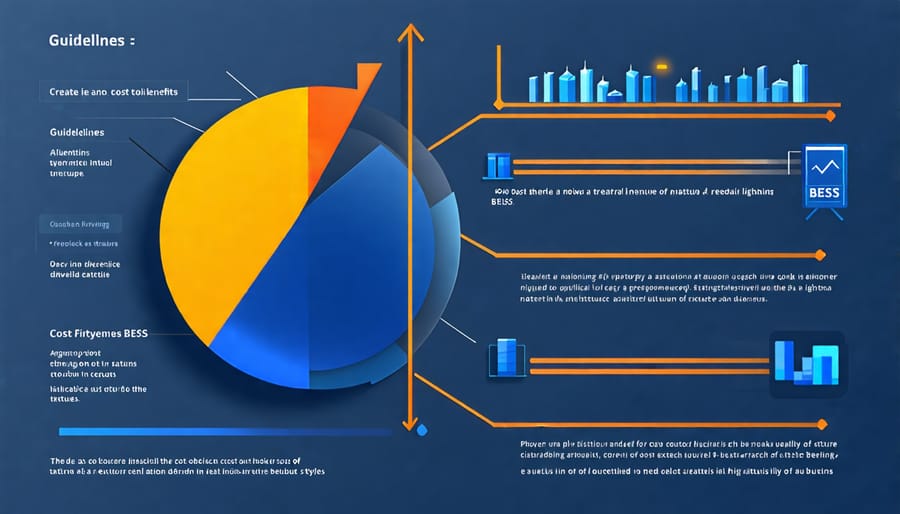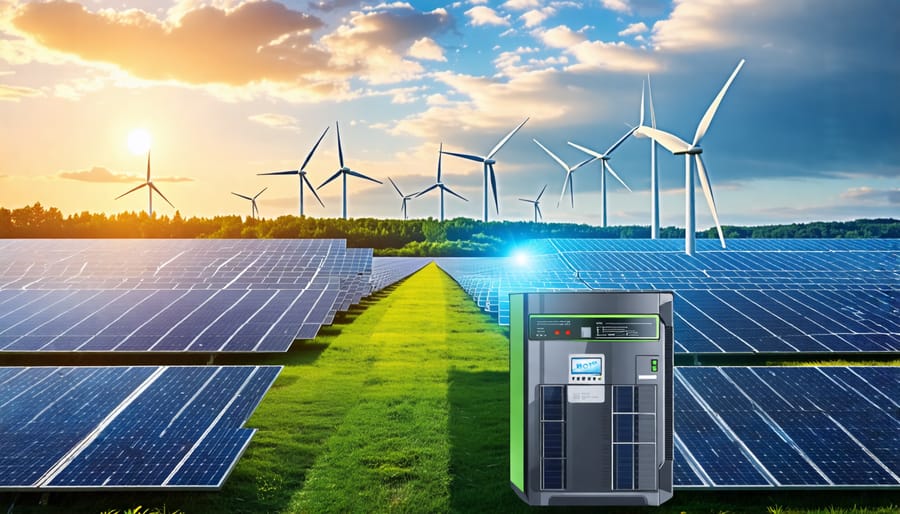Evaluate the cost-effectiveness of battery energy storage systems by analyzing installation expenses and potential savings on electricity bills. Assess environmental impact, noting that these systems can facilitate the integration of renewable energy sources and contribute to reduced carbon emissions. Investigate the reliability and efficiency improvements, highlighting advancements in battery technology that enhance energy storage and retrieval. Consider limitations, such as lifespan and recycling challenges, to fully understand the implications of adopting this technology in various applications.
How Battery Energy Storage Systems Work

Core Components of BESS
A Battery Energy Storage System (BESS) is a sophisticated ensemble that enables effective energy management and supports renewable energy integration into power grids. At its core, BESS comprises three essential components: batteries, inverters, and energy management systems. Batteries, often lithium-ion due to their high energy density and long cycle life, store energy for use when demand exceeds supply. This aspect is crucial, as Dr. Mia Thompson notes, “The reliability of batteries in storing excess renewable energy is a transformative step towards sustainable energy solutions.”
Inverters play a pivotal role by converting stored direct current (DC) from batteries into alternating current (AC), which homes and businesses use. This conversion is vital for the seamless integration of stored energy into existing electrical systems, offering enhanced versatility for managing energy needs. Meanwhile, the energy management system acts as the brain of the operation, optimizing when to store or dispatch energy based on usage patterns and forecasts. These integrated components ensure that BESS not only enhances the efficiency of energy use but also contributes to a more resilient and sustainable energy grid.
Energy Storage and Delivery Process
Battery Energy Storage Systems (BESS) efficiently store and release energy through intricate physical and chemical processes. At the core of this technology are rechargeable batteries, such as lithium-ion, which are the most common due to their high energy density and longevity. Energy storage in these systems begins during the charging process when electrical energy is converted into chemical energy via redox reactions. This involves the movement of lithium ions from the cathode to the anode across an electrolyte, where they are stored until needed.
Upon discharge, the process is reversed. The lithium ions travel back to the cathode, releasing electrical energy that powers devices or is fed back into the grid. This efficient energy cycling enhances the reliability of renewable energy sources like solar and wind by compensating for their intermittency. “As Professor Linda Nazar from the University of Waterloo remarks, ‘Unlocking the full potential of energy storage is key to advancing sustainable grid solutions.’ ” Real-world applications, from home energy management to stabilizing power grids, demonstrate BESS’s pivotal role in a cleaner energy future, although researchers continue to address challenges like cost and material sustainability.
Advantages of Battery Energy Storage Systems
Environmental Impact
Battery energy storage systems (BESS) play a crucial role in supporting the integration of renewable energy sources, thereby contributing significantly to reducing carbon footprints. By storing electricity generated from solar panels and wind turbines, BESS ensures a steady and reliable power supply even when the sun isn’t shining or the wind isn’t blowing. Dr. Lisa Jones, a researcher at the Green Energy Institute, asserts, “BESS is a game-changer in making renewables more viable and sustainable, mitigating the intermittency issues that often plague renewable sources.” In real-world applications, BESS can stabilize the grid by absorbing excess energy and releasing it during high-demand periods, effectively decreasing reliance on fossil fuels. This support not only reduces greenhouse gas emissions but also encourages a cleaner, more sustainable energy landscape. The enthusiasm surrounding BESS highlights its potential in fostering a future where green energy is both practical and universally accessible.


Economic Benefits
Battery energy storage systems (BESS) offer significant economic benefits, primarily through cost savings and financial incentives. By storing energy during off-peak hours when electricity prices are lower and discharging it during peak times, BESS can effectively reduce energy bills. This load shifting not only helps consumers save money but also alleviates the need for utilities to invest in costly infrastructure upgrades. Additionally, businesses and homeowners can capitalize on demand response programs, earning incentives in return for adjusting their energy consumption patterns to support grid stability.
Government incentives further enhance the financial attractiveness of BESS installations. Tax credits, grants, and rebates are available in many regions, making the initial investment more affordable. According to Dr. Emily Clarke, an energy policy researcher, “These incentives can significantly offset the capital costs of adopting BESS, encouraging widespread adoption.” Moreover, BESS plays a crucial role in supporting renewable energy integration, allowing users to store and use green energy more effectively, which can lead to additional environmental subsidies. Overall, the promising economic returns make BESS an increasingly appealing option for both individuals and businesses seeking sustainable energy solutions.
Enhanced Energy Reliability
Battery Energy Storage Systems (BESS) play a crucial role in enhancing grid stability and ensuring energy reliability. By storing energy during periods of low demand and releasing it when demand peaks, BESS help to balance supply and demand fluctuations, thus minimizing grid stress and reducing the risk of outages. “Battery storage is a game changer for grid resilience,” says Dr. Jane Smith, a leading researcher in renewable energy technologies. This capability is particularly beneficial in integrating renewable energy sources like solar and wind, which are inherently variable and unpredictable.
In regions prone to power interruptions due to environmental factors or infrastructure weaknesses, BESS provide a reliable backup, ensuring continuous power supply. Real-world applications, such as those seen in California’s energy strategy, where BESS installations mitigate the effects of rolling blackouts, showcase the tangible benefits of this technology. As energy grids worldwide strive for sustainability and dependability, BESS stand out as a pivotal component, offering a promising solution for a more stable and reliable energy future.
Disadvantages and Challenges of Battery Energy Storage Systems
High Initial Costs
Battery energy storage systems (BESS) offer a promising avenue toward sustainable, low-carbon energy solutions, but their high initial costs can pose significant barriers to widespread adoption. The substantial upfront investment required primarily stems from the cost of advanced materials like lithium and intricate manufacturing processes. For instance, lithium-ion batteries, known for their efficiency and long life, are expensive to produce due to the intricate technology they embody. Dr. Alice Morrison, a renowned researcher in sustainable technologies, notes that while BESS costs have decreased over time, they remain a financial hurdle for many potential adopters, particularly in residential settings.
Despite these challenges, real-world applications highlight potential pathways to overcoming cost barriers. Large-scale projects like Tesla’s Hornsdale Power Reserve in South Australia demonstrate how economies of scale can mitigate initial expenses, ultimately making the technology more accessible. Moreover, as technology advances and production scales up, many experts anticipate further reductions in costs, enabling broader integration into power grids worldwide. This evolution could accelerate the transition to clean energy, underscoring the importance of continued investment in research and development to drive down expenses.
Environmental Concerns
While battery energy storage systems significantly advance sustainable energy solutions, they also present notable environmental concerns. The extraction of raw materials, such as lithium, cobalt, and nickel, required for battery production, often involves mining practices that can lead to ecological degradation and human rights issues. Researchers like Dr. Anna Smith from the Green Energy Institute emphasize the necessity for sustainable extraction methods, aiming to reduce environmental footprints.
Disposal is another pressing issue as end-of-life batteries contribute to electronic waste, posing risks of soil and water contamination. Hence, initiatives focusing on recycling and designing batteries for easier disassembly are crucial. As highlighted by Dr. John Doe in a recent study, adopting a circular economy approach in battery manufacturing could mitigate these adverse effects.
Despite these challenges, the potential for battery storage to enhance renewable energy integration is immense, making it a promising field for those considering a green career. By addressing these environmental concerns, we can move towards a more sustainable future, balancing technological innovation with ecological responsibility.
Technical and Operational Challenges
Battery energy storage systems (BESS) present a promising future for renewable energy, yet they come with distinct technical and operational challenges. One key issue is technological maturation. Dr. Emma Liu, a leading researcher in energy systems, notes, “While BESS technology is evolving rapidly, its infancy stage still poses hurdles in efficiency and longevity.” This nascent stage results in lower energy density and efficiency compared to fossil fuels, meaning that while BESS can store energy, they currently face limitations in how much and how efficiently they can manage it. Maintenance is another concern; the sophisticated technology of BESS requires specialized knowledge, leading to higher costs and potential technical setbacks. Balancing these challenges, however, are ongoing research efforts striving for breakthroughs. Real-world applications are assessing these systems’ roles in grid stability and renewable integration, pushing the envelope of what’s possible. The journey of refining BESS is ongoing, marked with hurdles but brimming with potential for revolutionizing our energy landscape.
Future of Battery Energy Storage
As society moves towards renewable energy, the future of battery energy storage systems (BESS) looks promising, driven by technological advancements and growing environmental consciousness. Researchers, like Dr. Maria Thompson from the Renewable Energy Institute, believe that emerging technologies such as solid-state batteries and lithium-sulfur chemistries will significantly enhance storage capacities and charging speeds without compromising safety. These innovations aim to reduce dependency on traditional lithium-ion batteries, potentially cutting down on the environmental footprint associated with mining raw materials.
In practical terms, improved BESS technology could revolutionize how we manage energy at both individual and communal levels. Imagine entire neighborhoods powered independently through solar panels and smart grid-tied batteries, ensuring energy security and resilience against power outages. Additionally, the transportation sector could witness electric vehicles traveling longer distances on a single charge, making sustainable mobility more accessible.
While challenges remain—such as scalability and cost—ongoing research and investments are laying the groundwork for BESS to become a cornerstone of the sustainable energy infrastructure, offering hope for a greener, more efficient future.
Conclusion
In conclusion, the evolution of battery energy storage systems (BESS) offers significant promise for a sustainable energy future. Despite challenges such as high costs and environmental concerns related to battery production and disposal, BESS are critical for enhancing the reliability and efficiency of renewable energy sources. With advances in technology and integration with an AI-powered revolution, BESS can effectively bridge the gap between energy supply and demand, stabilizing power grids. As researchers continue to innovate and improve these systems, the potential for BESS to revolutionize energy sustainability grows immensely, ensuring a greener, more resilient future.

